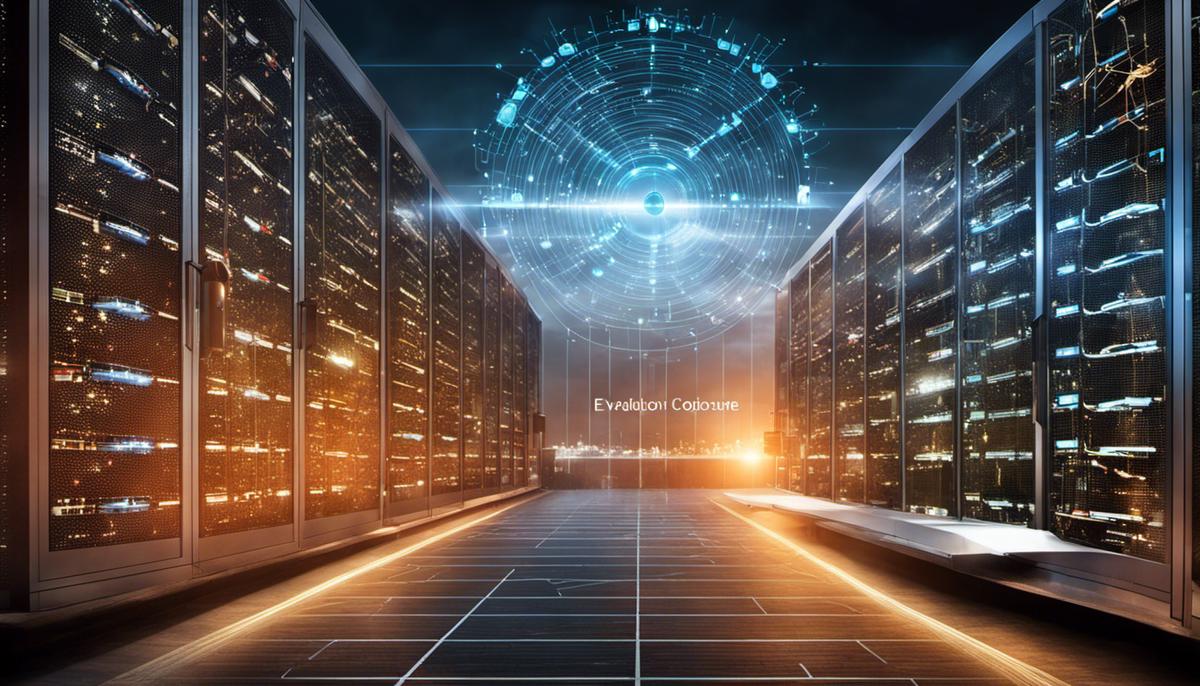Research on cyber security has never been more crucial. From humble beginnings founded on simple brute-force attacks and primitive phishing schemes to an intricate battlefield teeming with sophisticated malware and innovative defensive strategies, the evolution of cyber security has mirrored the complexities of our growing digital ecosystem. Covering a spectrum from historical advancements to modernized defense mechanisms and the role of AI and machine learning, this analysis aims to shed light on the intricacies of the cyber world. Moreover, an understanding of national and international policies and anticipating future trends provides a holistic purview of the current state and potential trajectory of this critical domain.
The Evolution of Cyber Security
The Evolution of Cybersecurity: A Vigilance Story
Since the first inception of information communication, cybersecurity has been hiding in the background, evolving in harmony with our technological advances. It marches forward, adopting new tactics and methods in this ever-changing world of digital communication. One cannot oversimplify the changes this field has undergone, as its evolution reflects our firm grasp on technology, adaptiveness, and the continuous struggle to safeguard delicate, valuable information.
In the infancy of its existence, cybersecurity was uncomplicated and straightforward–a simple mechanism to protect systems from juvenile pranks and minuscule data fiddles. It grew out of an age when computers were massive cabinets housing exposed vacuum tubes and rotating reels. Security then primarily concerned itself with the physical–locks, keys, and restricted access areas. The digitization and interconnectedness of modern networks were yet to be a glimmer on the horizon.
The true metamorphosis became evident with the advent of Web 1.0 and the internet’s promise of connectivity, propelling cybersecurity into uncharted waters. It was the heralding note of a shift from mere physical keys and locks to fiery walls and intricate cryptographic measures. This era burgeoned the concept of firewalls, a cornerstone of cybersecurity, contrived to protect Local Area Networks from malicious attacks. Intrusion Detection Systems (IDS) and Anti-Virus software also became mainstream, providing a critical bulwark against cyber threats.
The advent of Web 2.0 and the accompanying social media boom brought forth a new kind of threat – the explosive dissemination of information. Personal data became a hot commodity, shared carelessly across platforms, making it a potentially lucrative target for adversaries. This simultaneously necessitated the enhancement of legislation and led to an increased emphasis on privacy, encryption, and user awareness. Concepts like two-factor authentications and complex password requirements were incorporated into the standard cybersecurity practices as we acknowledged our interdependence and the intrinsic fragility of the digital domain.
Fast forward to now, and we grapple with Artificial Intelligence (AI) and the Internet of Things (IoT). Sophisticated cyber threats now camouflage themselves in unprecedented ways, constantly mutating and challenging security experts. Today’s defense strategies incorporate AI and machine learning techniques, predicatively analyzing patterns to anticipate and mitigate attacks. IoT, however, brings a new level of complexity with an array of scattered devices, creating a larger surface area for attacks. As a result, cybersecurity has grown into a proactive defense principle rather than its previous reactive stance.
Peering into the future, one anticipates quantum computing to propel cybersecurity to further heights or depths. This technology forebodes a different battlefield – one that promises to crack our robust encryption systems with relative ease while potentially offering near-impenetrable security alternatives.
Nonetheless, the essence of cybersecurity remains constant – protecting the integrity of information. Even as the tactics and techniques transform with each leap in technology, the overarching principle endures. The game board may change, but the players’ intent remains the same: to defend the dikes of data from the floods of cyber threats. Each epoch finds cybersecurity adapting, growing, and refining its strategies, delivering a dynamic narrative of perpetual vigilance.

Current Threat Landscape and Defense Mechanisms
A Gaze at the Current Cybersecurity Landscape: Threat Manifestations and Defenses
To efficiently map out the present-day cybersecurity landscape, it is first critical to recognize the multifaceted, evolving nature of threats. There has been a noticeable shift toward increasing sophistication in cyber attacks, away from standalone threats to coordinated, multi-stage invasions.
One prevailing villain, advancing beyond the perimeter firewall construct, is Advanced Persistent Threats (APTs). APTs embody an orchestrated network attack in which perpetrators gain unauthorized access and remain undetected for extended periods. Stealth and constancy are cornerstones, rendering traditional detection systems largely ineffective. SETI@home and Stuxnet are historically notable instances of how APTs can compromise entire infrastructures.
Alongside APTs, a parallel surge in ransomware campaigns has imposed additional pressure on cybersecurity resilience. Here, malefactors encrypt the victim’s data, compelling a payment (ransom) to restore access. Amongst others, WannaCry and NotPetya illustrate the compelling capacity of ransomware to paralyze organizations.
Furthermore, the confluence of the cloud and cybersecurity has provoked a significant shift towards securing cloud-based assets with the advent of Cloud Access Security Brokers (CASBs). As corporations transit from in-house servers to cloud services, attack vectors have similarly evolved. CASBs act as a control point, ensuring visibility, compliance, data security, and threat protection.
To counter these inexorable threats, humankind’s best tools evolve in tandem. Defensive strategies often denote a two-pronged approach involving both proactive measures and recovery processes.
In proactive terms, intrusion detection/prevention systems (IDS/IPS) and honeypots have been instrumental. IDS/IPS offers real-time protection, identifying possible incidents, logging pertinent information, and preventing multiple intrusions. On another wavelength, honeypots, by luring adversaries into a decoy network, assist in understanding hackers’ methodology, hence enhancing future defense mechanisms.
Yet, the fact remains absolute prevention is aspirational but not yet feasible. Thus, recovery measures, namely backups and disaster recovery plans, are essential. A well-structured recovery strategy can mitigate losses, permitting rapid restoration of functions after a security infringement.
Additionally, in a future-facing approach, cyber threat intelligence (CTI) is garnering traction. By leveraging knowledge about adversary techniques, capabilities, and intentions, CTI aims to predict and preclude future attacks.
In essence, deep within the crevices of today’s cybersecurity landscape exist threats of remarkable finesse, daring human ingenuity to construct formidable defenses. It is an intricate dance of ciphers and codes, protection and complicity. Yet at its crux, beyond the algorithms and programming, thrives a burning pursuit of preserving the sanctity of information, propelling the ceaseless churn of cybersecurity evolution.

The Role of AI and Machine Learning on Research of Cyber Security
Expanding upon the role of artificial intelligence (AI) and machine learning in cybersecurity, it’s increasingly evident that these technologies are contributing heavily to alterations in cyber offense and defense methodologies. Posing a symbiotic interplay, AI and machine learning are deployed not only in the hands of defenders but also in those of cyber attackers. AI-driven cybersecurity is thereby appearing as a double-edged sword within the realm of digital security.
Traditional threats such as Advanced Persistent Threats (APTs) and ransomware campaigns have certainly evolved, strategically incorporating AI and machine learning to streamline their attacks. APTs, renowned for their stealthy and long-term presence in the targeted infrastructure, now exploit AI for pattern recognition, enabling them to blend seamlessly within everyday digital communication and thus linger undetected. Simultaneously, ransomware campaigns have seen advancements through machine learning algorithms, enhancing their potential to identify vulnerabilities ensuring a higher infection rate and impact.
On the other side of the coin, AI and machine learning have immensely fortified defense mechanisms within cybersecurity itself. Cloud Access Security Brokers (CASBs), for instance, leverage machine learning algorithms to identify unusual behavior patterns in cloud data access, thereby mitigating cloud-related cybersecurity risks.
Proactive measures have been amplified through the integration of AI and machine learning as well. Intrusion detection and prevention systems, when reinforced with machine learning, envisage potential threats, ensuring real-time response to impending cyber-attacks. Furthermore, honeypots – decoy systems meant to entice hackers – nourished by machine learning, imitate target systems more effectively, thereby providing viable insights into the strategies and motivations of the potential attacker.
Moreover, AI and machine learning have given rise to anticipatory and efficacious recovery measures. Backups and disaster recovery strategies employ AI to improve their decision-making process, enabling swifter detection and recovery from cyber-attacks. Consequent to this acceleration in recovery, businesses are expected to curtail their downtime, thus attenuating potential losses.
Significantly, cyber threat intelligence (CTI) – a crucial aspect of an organization’s cybersecurity framework – has embraced AI and machine learning to enhance its threat detection and response capabilities. Advanced machine learning algorithms sift through massive CTI data, discerning patterns and correlations that enable accurate predictions of diverse threat vectors.
Evolution in both cybersecurity threats and defenses is dictated by the constant tug-of-war between cyber attackers and defenders, both of whom strive to outdo one another. With AI and machine learning on board, this evolution has become more dynamic and, simultaneously, more nuanced. It’s, therefore, imperative for cybersecurity professionals to comprehend the core capabilities of these technologies and the range of their potential applications. The incorporation of these advances ensures the realization of an efficacious and sophisticated state of cyber resiliency, which ultimately helps to safeguard the integrity of information.

Cyber Security Policies and Regulations
Key Cybersecurity Policies and Regulations: Guiding Principles in the Field
The field of cybersecurity, a thriving cross-section of the digital revolution and modern technology, must be guided by comprehensive and well-devised strategies. This direction falls under critical cybersecurity policies and essential regulations that maintain order amidst an ever-evolving terrain of digital threats.
At the heart of cybersecurity is the obligation to maintain the confidentiality, integrity, and availability of data, a principle set forth by the classic CIA triad. NIST (National Institute of Standards and Technology) in the U.S. has been instrumental in establishing key cybersecurity policies. Particularly, the NIST Cybersecurity Framework, first published in 2014, offers core guidance for private sector organizations in the U.S. to manage better and reduce cybersecurity risk. This framework has gained momentum, guiding not just domestic but international establishments in strengthening cybersecurity across sectors.
ISO/IEC 27001 is a globally acknowledged standard that outlines how to implement a robust and comprehensive Information Security Management System. Issued by the International Organization for Standardization (ISO), alongside the International Electrotechnical Commission (IEC), it accompanies an array of standards designed to help organizations manage their information security processes in line with international best practice.
Furthermore, the Federal Information Security Modernization Act (FISMA), operating in the U.S., requires federal agencies to incorporate comprehensive cybersecurity defenses, performing regular evaluations and reports on the effectiveness of their cybersecurity posture.
The European counterpart, the General Data Protection Regulation (GDPR), has emerged as a significant regulatory shift, applying stringent principles on how data is processed and protected, extending its influence beyond European borders and into global corporations.
Similarly, the Health Insurance Portability and Accountability Act (HIPAA) in the U.S. set out data privacy and security provisions for securing medical information. It underscores the increasing pertinence of maintaining confidentiality within the sector, which is particularly vulnerable to cyber threats.
Nevertheless, key principles from the Payment Card Industry Data Security Standard (PCI DSS) underline the securing of cardholder data, decisively contributing to global transactions’ safety.
Another integral policy is the Defense Federal Acquisition Regulation Supplement (DFARS), which focuses specifically on protecting Controlled Unclassified Information (CUI) within non-federal systems and networks, a major concern for governmental contractors.
Hence, cybersecurity is not an isolated realm but a multi-faceted and deeply interconnected sphere, demanding regulations and policies that can keep pace with the speed of technological advances. Cybersecurity policies and regulations, although numerous, hold a common underpinning: they are designed to protect, guard, and sustain the secure flow of information within and beyond an organization’s boundaries. They highlight the need for a cohesive strategy, symbiotic relationships, and shared information, reaffirming the importance of global benchmarks in maintaining a robust cybersecurity stance. As the cyber landscape continues to evolve, these regulations play an indispensable role in maintaining control over a constantly transforming digital environment.

Future Trends in Cyber Security
Building upon traditional cybersecurity measures and the integration of artificial intelligence and machine learning into these processes, the field is now directed toward considerations pertinent to international standards and compliance regulations. These standards and regulations, which include the CIA triad, the NIST Cybersecurity Framework, ISO/IEC 27001, the Federal Information Security Modernization Act (FISMA), the General Data Protection Regulation (GDPR), the Health Insurance Portability and Accountability Act (HIPAA), the Payment Card Industry Data Security Standard (PCI DSS), and the Defense Federal Acquisition Regulation Supplement (DFARS), underscore the paramount importance of data protection across sectors and geographies.
Consider the CIA triad, the cornerstone of information security. It stands for Confidentiality, Integrity, and Availability. As the field sends us spiraling into an increasingly digitized age, balancing the triad remains a key challenge. As measures evolve to secure data confidentiality and maintain system availability, integrity – ensuring data remains accurate and reliable – soars as a pressing concern. New and improved strategies are required to uphold this trinity in diverse environments across the globe consistently.
The NIST Cybersecurity Framework, a voluntary guide delineated by the National Institute of Standards and Technology, has left an extensive impact on private sector organizations. As these organizations steer towards domains prone to potential threats and vulnerabilities, the implementation of this framework assists in identifying, preventing, detecting, and responding to cyber risks. It provides a structured methodology that encourages regular audits and assessments, alleviating the latent insecurity surrounding cyber threats.
Expanding on the global scale, the ISO/IEC 27001 cultivates a standardized approach for an Information Security Management System (ISMS). The provision of a detailed roadmap for establishing, implementing, maintaining, and improving an organization’s ISMS poses as an influential means to ensure compliance with international best practices.
Meanwhile, the FISMA is critical for federal agencies in the United States. It emphasizes the development and implementation of mandatory standards and processes that ensure information security and shield federal information and data from potential cybersecurity threats.
FISMA’s European Union counterpart, the GDPR, forced industries across the globe to reimagine and restructure their data governance practices. The shared emphasis on individual’s rights over personal data redefined principles for data processing and protection, thereby prompting organizations to be cautious about their data handling operations – specifically focusing on transparency, purpose limitation, data minimization, accuracy, storage limitation, integrity and confidentiality, and accountability.
HIPAA, catering to the healthcare industry’s specific needs, lays down comprehensive provisions for securing medical information. As the industry becomes more tech-savvy, such provisions play a critical role in addressing potential vulnerabilities and securing sensitive health information in an increasingly digital era.
Similarly, the PCI DSS, specifically crafted for the financial sector, underscores the importance of securing cardholder data. Stringent adherence to its guidelines is crucial to protect against data breaches that could potentially expose cardholder data, inflict substantial financial losses, and severely damage the reputations of the involved organizations.
Lastly, DFARS focuses on protecting Controlled Unclassified Information (CUI) in non-federal systems and networks. As such, it offers a standard for government contractors to ensure they meet certain benchmarks related to data protection and cybersecurity.
In the grand landscape of cybersecurity, the advent of immersive standards and compliance regulations has undoubtedly dictated newer directions. Future cybersecurity strategies will need to delicately balance the pressing need to safeguard digital infrastructure, accommodate innovative technologies, and meet the stringent demands of an exponentially growing compliance landscape. The way forward lies in the harmonious orchestration of technology, practices, and regulations, ultimately manifesting in secure, robust, and resilient cyber environments.

Ensuring cyber security in the current threat landscape while anticipating a future filled with complex challenges is a test for the global community. Future trends like quantum computing, IoT security, and blockchain technology are the harbingers of new-era threats and defenses. Effective countermeasures seek a synergy between adaptive strategies, potent technologies, and an efficient regulatory framework. The role of industry collaboration, public-private partnerships, and informed populace forms the cornerstone in this dynamic landscape. As we stand on the precipice of this digital revolution, understanding and navigating the realms of cyber security will be our compass toward a more empowered and secure digital ecosystem.

